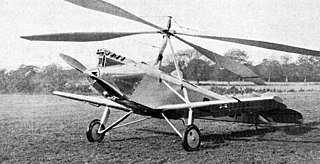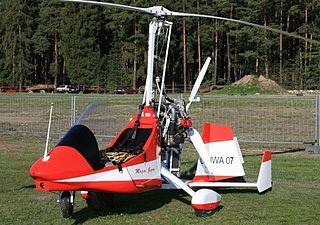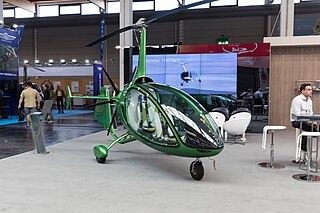Related Research Articles

The Bensen B-8 is a small, single-seat autogyro developed in the United States in the 1950s. Although the original manufacturer stopped production in 1987, plans for homebuilders are still available as of 2019. Its design was a refinement of the Bensen B-7, and like that aircraft, the B-8 was initially built as an unpowered rotor-kite. It first flew in this form in 1955, and on 6 December a powered version, designated B-8M first flew. The design proved to be extremely popular and long-lasting, with thousands of sets of plans sold over the next thirty years.

The PAC Cresco is a turboprop-powered derivative of the FU-24 PAC Fletcher aerial topdressing aircraft, manufactured by the Pacific Aerospace Corporation in Hamilton, New Zealand. The Cresco was superseded by the P-750XSTOL in the early 21st century but in 2019 was returned to production with the first new aircraft being completed 3 December 2020.

The Fuji FA-200 Aero Subaru is a single-engine piston-powered monoplane built by Fuji Heavy Industries of Japan.
The Aeronca Model 9 Arrow was a low-wing all-metal cabin monoplane with retractable landing gear. It was marketed to returning pilots from World War II and unveiled in 1947 but never went into production.

The Albatros L 75 Ass was a German trainer biplane of the 1920s. Of conventional configuration, it seated the pilot and instructor in separate, open cockpits. The wings were single-bay, equal-span, and had a slight stagger. Production continued after Albatros was absorbed by Focke-Wulf.

The Arado Ar 76 was a German aircraft of the 1930s, designed as a light fighter with a secondary role as an advanced trainer in mind.
The PZL M-24 Dromader Super is a single engine agricultural aircraft, developed in the 1980s by the WSK-Mielec from the PZL-Mielec M-18 Dromader. It remained a prototype.

The Britten Sheriff was a light twin-piston engine aircraft developed in the United Kingdom in the 1970s. Intended to be produced outside of the UK, the company went into receivership in 1984 and the aircraft was never completed.

The AS/SA 202 Bravo is a two to three-seat civil light aircraft jointly designed and manufactured by the Swiss company Flug- und Fahrzeugwerke Altenrhein (FFA) and the Italian company Savoia-Marchetti. The aircraft was designated the AS 202 in Switzerland, and the SA 202 in Italy.

The Cierva C.17 was a British experimental autogyro built by Cierva Autogiro Company in England in 1928, in association with Avro. It was an attempt to build upon the successful Cierva C.8 design using the smaller, more streamlined fuselage of an Avro Avian IIIA as a starting point. The type was found to be underpowered, and when the first attempt at fitting a more powerful engine still did not result in acceptable performance, the design was abandoned.
The Davis DA-5, a.k.a. DA-5A, is a single-seat sport aircraft designed in the United States in the 1970s and marketed for homebuilding. Like designer Leeon D. Davis's successful DA-2, it is a low-wing monoplane with fixed tricycle undercarriage and a V-tail, but with a much narrower fuselage accommodating only the pilot, and a lengthened nose. Design work was carried out in 1972, but the prototype was not built until 1974, when it was completed in only 67 days.

The IAR-46 is a very light two-seater airplane for flight schools, training and tourism. Construction uses conventional riveted joints. The seats are arranged side by side, the conventional left seat being the pilot or student pilot seat. The aircraft has a low trapezoidal wing, empennage in "T" configuration, semi-retractable landing gear (mechanical), with the tailwheel connected to the rudder.

The Pitcairn PA-34 and Pitcairn PA-33, given the United States Navy (USN) designation Pitcairn OP-2 and United States Army designation Pitcairn YG-2 respectively were reconnaissance auto-gyros designed and built in 1936 for evaluation.
The CSIR SARA II is a South African two-seat experimental autogyro designed and built by the Aeronautics Research Unit of the Council for Scientific and Industrial Research.
The Aero-Astra Okhotnik is a Russian single engine, three seat autogyro of pusher, pod and boom configuration. It has been developed into several variants from 2001 to 2007.

The Turbay T-3A was an Argentine twin-engined seven-seater light transport of the 1960s. A single example was built, but no production followed.
The ArrowCopter is a series of Austrian autogyros, designed and produced by FD-Composites GmbH of Zeillern. When it was in production the ArrowCopter AC20 series was supplied as complete, factory built, ready-to-fly-aircraft.

The Magni M-14 Scout is an Italian autogyro, designed and produced by Magni Gyro srl of Besnate. The aircraft is supplied as a complete ready-to-fly-aircraft.

The Niki Lightning is a fully enclosed two-seater tricycle autogyro of composite construction, designed and built by Niki Rotor Aviation in Bulgaria. It was introduced in 2009

The Niki Kallithea is a Bulgarian autogyro designed and produced by Niki Rotor Aviation of Pravets, introduced in 2011. The aircraft is supplied complete and ready-to-fly.
References
- 1 2 Taylor 1976, p. 206
- Taylor, John W. R., ed. (1976). Jane's All the World's Aircraft 1976–77. London: Jane's Yearbooks. ISBN 0-354-00538-3.
- Taylor, Michael J. H. (1989). Jane's Encyclopedia of Aviation. London: Studio Editions. p. 32.
- US Patent 4071206